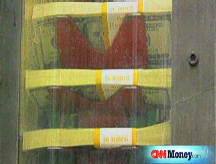The dollar's short-lived comeback
The greenback has rebounded nicely from lows hit in April. But some currency experts don't expect it to last.
NEW YORK (CNNMoney.com) -- The sick dollar may be getting a little healthier - but it is far from making a full recovery.
After slipping to record lows against the euro in April, the greenback has recovered in recent weeks, helped in part by expectations that the Federal Reserve's aggressive rate-cutting campaign may have reached a stopping point.
But with the U.S. economy under strain, resistance by foreign central banks to cut interest rates and a massive U.S. trade deficit, a number of currency experts are betting the dollar will stay under pressure at least through the remainder of the year.
"The recent strength we've been seeing is not a turn in the dollar so to speak," said Phyllis Papadavid, a senior currency strategist at Societe Generale in London, adding that the dollar's recent bounce will be short lived because of economic concerns.
To that end, the latest reading on manufacturing activity fell more sharply than expected in April, while retail sales, which drive two thirds of economic activity in the United States, also suffered a decline last month.
At the same time, there has been further fallout in the housing market and unemployment is on the rise.
Even though the weakened dollar has helped boost the nation's exports by making goods manufactured in the United States more attractive to foreign buyers, the nation's current account deficit - which measures trade with the rest of the world - is still massive.
The deficit was a whopping $738.6 billion at the end of last year. While that's down from $811.5 billion in 2006, it's still large enough to be a concern since the current account deficit has to be covered by borrowing from overseas investors.
If these investors pull their money from the U.S., that could result in a cycle of falling stock and bond prices and ultimately a further decline in the value of the dollar.
In addition, foreign central bankers have been reluctant to cut interest rates, which has also helped spur the dollar's weakness. Both the European Central Bank and the Bank of England held interest rates steady last week.
Still, it is understandable why a growing number of experts are betting on a dollar rebound.
Foreign investors, for example, are buying more U.S. securities than they are selling, which help supports the dollar.
According to the most recent Treasury International Capital report, a monthly reading which measures foreign investment flows, net foreign purchases of long-term U.S. securities were $80.4 billion in March, up from net purchases of $64.9 billion in February and $56.7 billion in January.
At the same time, futures markets suggest that if the Fed takes any action in the coming months, it will be a rate hike to keep inflation in check, which would also boost the greenback.
Right now, investors are pricing in a scenario in which the central bank leaves interest rates unchanged at 2% during the summer, and a better than 50-50 chance it will raise rates by a quarter of a percentage point when policymakers rendezvous at the end of October.
What's more, most eligible Americans still have not received their economic stimulus check, which could provide a much-needed shot in the arm to both the U.S. economy and the dollar.
But others say it's uncertain whether the economic stimulus checks will be enough to heal the U.S. economy.
"We don't know if the stimulus checks will be a Band-Aid that will help the U.S. economy recover," said David Watt, a senior currency strategist at RBC Capital in Toronto. "Until we are clear about that, the U.S. dollar will struggle."
Plus, foreign investors can be a fickle bunch, and the difference between U.S. interest rates and other foreign central banks makes the dollar less attractive.
"At the end of the day, yields in the U.S. are far below yields [of other central banks]," said Daniel Katzive, a foreign exchange strategist at Credit Suisse.
So it is highly unlikely that the dollar will return to the levels it was at just a year ago, when 1 euro was worth $1.35 and a single dollar could fetch 120 Japanese yen.
In order for the dollar to get back to those levels, experts say the U.S. trade deficit would have to drastically shrink and the Fed would need to aggressively raise interest rates to combat inflation.
"It's probably going to be late 2009 before we get a real strong sustained bounce in the dollar," said Katzive. ![]()



